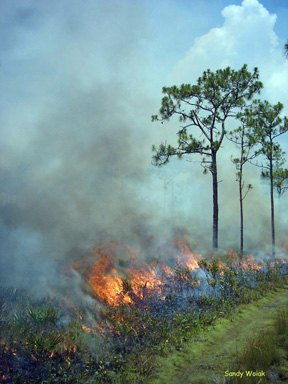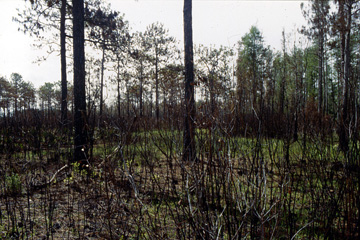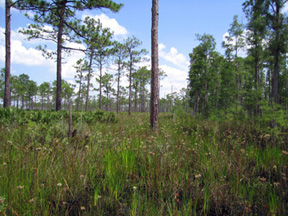By Victoria Parsons
John DeWolfe fights fires for a living. Sometimes he fights a more important, albeit less visible, battle –– helping prevent wildfires with prescribed burns.
“A lot of people think fire is fire, but that’s because they’ve never seen a wildfire,” says DeWolfe, a forest ranger with the Florida Division of Forestry based at Brooker Creek Preserve in northeastern Pinellas County. “Anyone who has experienced a wildfire pretty much supports prescribed burns because nothing stops wildfires better.”
Without an occasional fire, dry dead materials collect and become high levels of fuel that allow accidental fires to easily burn out of control. A case in point is the June fire at Brooker Creek, started when lightning struck in an isolated area of the 8500-acre preserve. “I can’t say it wouldn’t have caught fire, but the fire would have been safer and easier to control if the area had been burned recently,” he notes.

While homes surrounding the preserve were never threatened, it took firefighters nearly a week to contain the fire and people with heart or lung ailments and children at nearby schools were asked to stay indoors for the duration.
Even after six days and more than an inch of rain, the fire continued to smolder in a section of dried-out swamp, spreading underground where only huge amounts of water could reach it. “In this case, Mother Nature is the only thing that’s going to completely extinguish it,” he said.
Brooker Creek ecologists recognize the value of prescribed burns, but don’t always have sufficient staff to burn as much of the preserve as would be optimal. “Pinellas County does a good job at prescribed burns, particularly in critical areas next to subdivisions so that firefighters can get in,” DeWolfe said. “They do everything they can, but they have a lot of other priorities.”
Fire Restores Ecosystems
Along with protecting human lives and the structures we live in, prescribed burns are critical for many natural ecosystems in Florida, notes Gordon Fox, a University of South Florida professor who is studying the effects of fire at sites near USF and at The Nature Conservancy’s 12,000-acre preserve near Kissimmee, as well as in other locations around the world.
“Fire is a major part of the ecosystem in Florida and suppressing it can have severe consequences,” he said.
With funding from the National Science Foundation, Fox and his students are studying the growth and regrowth of longleaf pine in what may be one of the nation’s largest urban forests, stretching from USF’s square-mile Eco Area east through county-owned lands at Lettuce Lake and Morris Bridge.
Prescribed burns are scheduled only when multiple conditions, including weather, fuel load and wind direction, all indicate that they can be set safely.
“You could argue that longleaf pine trees are entirely dependent on fire, except that they’re growing in my backyard, which I hope hasn’t burned in the last 50 years,” he says. “But I would argue that extensive forests of longleaf pine are certainly dependent on fire.”
Pines, among the most fire-tolerant plants in the world, aren’t harmed by intense heat, but fire kills off young oak trees and other scrub that would otherwise shade out pine seedlings and the lower-growing plants and grasses that offer more beneficial habitat to wildlife like gopher tortoises and indigo snakes.
“Ideally you have diverse ecosystems and in Florida that typically requires fire,” Fox said. “Some ecosystems require fire every few years, others can go 50 years without burning, but there is plenty of evidence that fire is necessary in most ecosystems.”
Memories of Smokey the Bear aside, burned lands recover very quickly. Most animals flee instinctively, and many native plants, accustomed to occasional fires, have deep roots and rebound practically overnight. On the other hand, many exotic plants, including invasive species, may not grow back as rapidly so natural systems have a fighting chance to recover. (That general rule of thumb doesn’t always hold true. Melaleuca, a native of Australia where fires also are an important part of the natural system, tolerates fire extremely well, Fox notes.)

Other native plants, like wiregrass, begin to sprout on burned land within days. A favorite food of gopher tortoises that also provides critical habitat for other wildlife, wiregrass depends on regular summer fires to stimulate flowering and seed production.
Saw palmetto, a native plant that often dominates disturbed lands, creates a special challenge to ecosystem managers – and nearby residents. While they provide food and shelter for some wildlife, palmettos often grow so densely that other species are often crowded out. Pine trees in particular don’t do well in ecosystems dominated by palmetto, Fox notes.
Fire burns back the shrubbery, opening the understory to sun and allowing native plants to regenerate.
From a purely human perspective, dense growths of palmettos are one of the worst types of fuel. Their leaves are covered with a thick layer of wax that helps them survive long droughts. When they catch fire, the oily wax burns fiercely. But like many Florida natives, dense underground roots help them rebound from fire quickly. To control palmetto, managers may need to mechanically treat the plants by chopping up their roots before or after burns.
Suburbia Not Necessarily Safe
The fire at Brooker Creek Preserve also serves as a case in point for Tampa Bay residents comfortable that their suburban homes aren’t in danger of forest fires. “You may think Pinellas County is a concrete jungle, but people don’t realize how much land is sitting there with 40 or 50 years worth of fuel built up,” DeWolfe said.

And even wetlands that remained natural because they weren’t buildable can catch fire, Fox adds. “Just because it’s a cypress swamp doesn’t mean it’s not going to burn – even though it’s a swamp, it’s not wet all the time, and it could have lots of fuel if it hasn’t burned in the last 30 or 40 years.”
Until the early 1990s, fires were generally suppressed as quickly as possible. With the passage of the Prescribed Fire Act in 1990, Florida has become a national leader in prescribed burns, treating nearly two million acres a year with fire. That compares favorably with the 197,557 acres burned in 3,436 wildfires in the first half of 2005.
Although prescribed fires are set year-round, summer is prime time because they coincide with natural fires started by lightning from thunderstorms and woods are usually wet enough to minimize the possibility of losing control, DeWolfe said. Before they’re set, firefighters consider variables that range from weather and wind direction to the fuel load in a chosen block. And before DeWolfe starts a fire, experienced staff and redundant equipment are on site and ready to fight the fire if the wind shifts or the fuel load is higher than expected.
“We don’t just show up with a lighter and hope for the best,” he quips. “These are very carefully planned operations.”
Is Your Home Firewise?
Just as prescribed burns minimize available fuel if a wildfire strikes, the primary goal for firewise home is fuel reduction. To create a landscape that makes your home less vulnerable to wildfire, consider these points:
- Carefully space trees, and limit plantings to fire-resistant species including dogwood, viburnum, redbud, sycamore, magnolia, beautyberry, oaks, red maple, wild azalea, sweetgum, coontie, winged elm, black cherry, persimmon, wild plum, sugarberry, Florida soap-berry, fringetree, ferns, wild olive, blue beech and sparkleberry.
- Take out the “ladder fuels” – vegetation that serves as a link between grass and tree tops. These fuels can carry fire from vegetation to a structure or from a structure to vegetation.
- Keep trees and shrubs pruned. Prune all trees up to 6 to 10 feet from the ground.
- Mow your lawn regularly and dispose of cuttings and debris promptly.
- Keep your gutters, eaves, and roof clear of leaves and other debris.
- Clear dead wood and dense vegetation within 30 feet from your house, and move firewood away from your house or attachments like fences or decks.
For more information, visit www.floridadisaster.org or www.fldisasterkit.com.